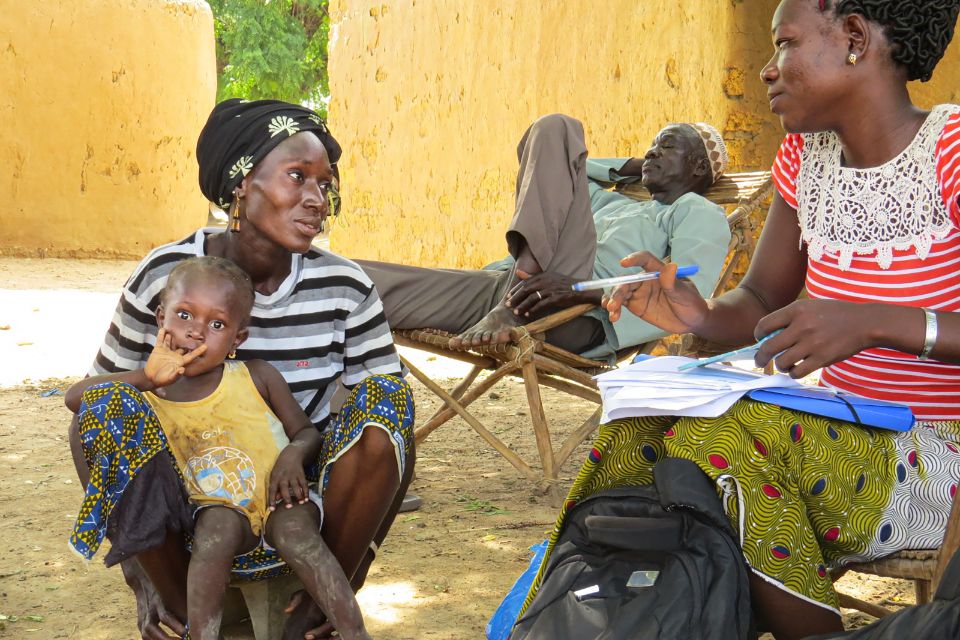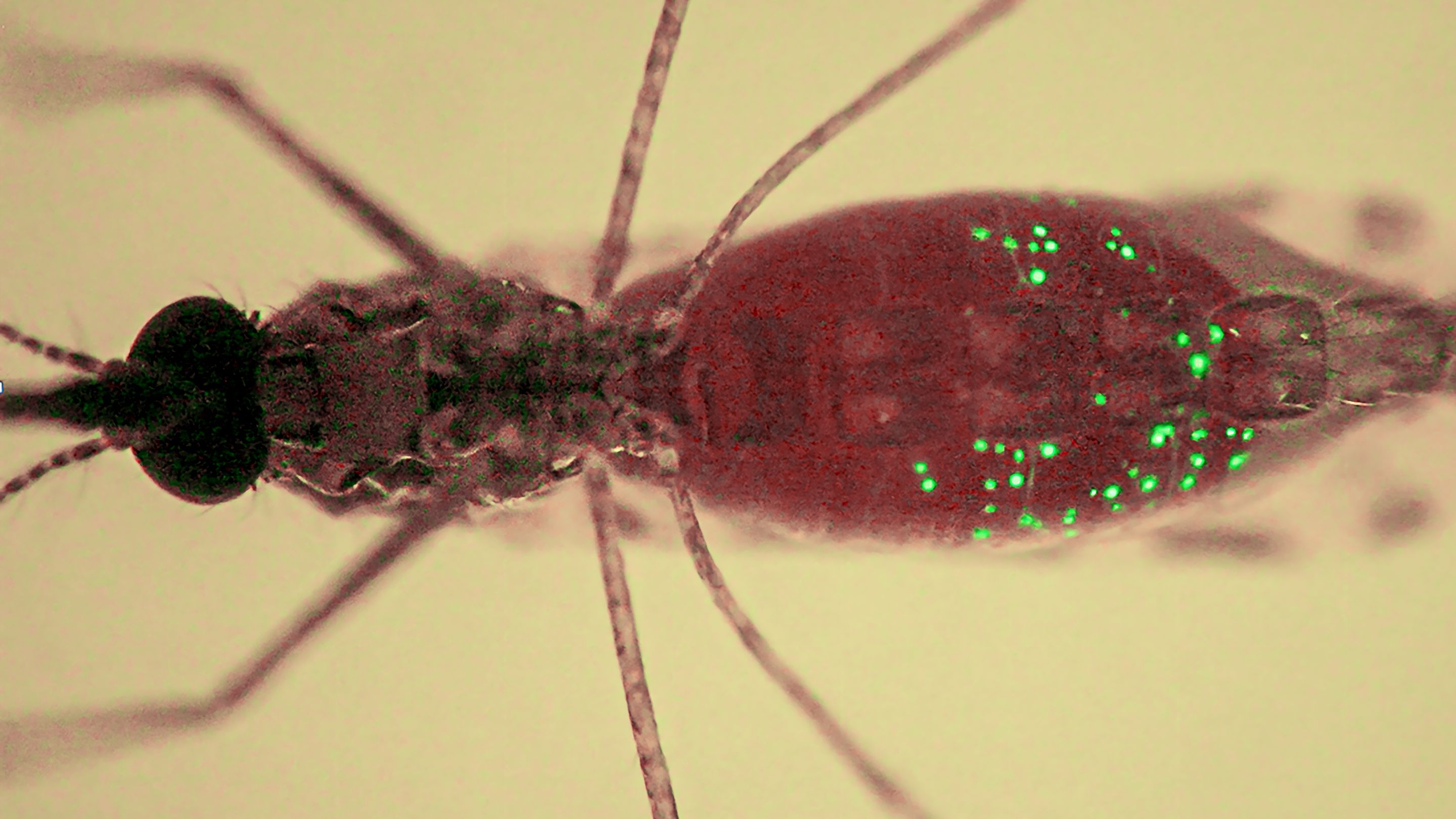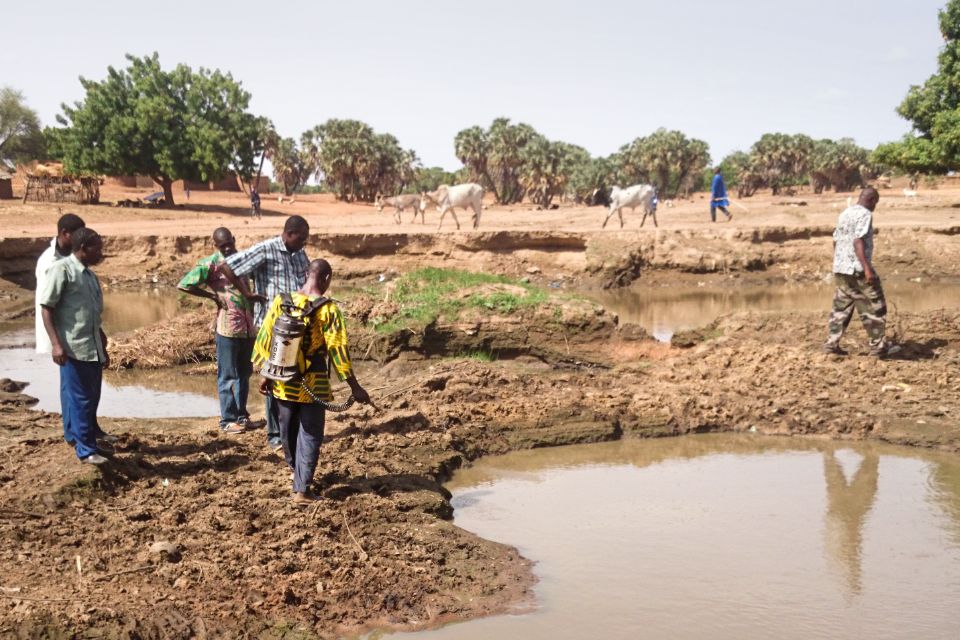- News 2023
- Facts & Figures
- Organisation
- Profile
- Focus 2023
- Downloads
-
Inhalte teilen:
Of Mosquitoes and Men
Malaria is spreading again – even towards Europe. In an interview, Professor Dr. Till Bärnighausen, Director of the Heidelberg Institute of Global Health, and Professor Dr. Friedrich Frischknecht, Head of a research group at the Center for Infectious Diseases, explain how the Anopheles mosquito can be contained, how the pathogen reproduces, and how mosquitoes can be used as vaccination assistants.
Professor Bärnighausen, you research health on a global scale. Today we are talking about malaria. Where does it occur, and which population groups are particularly threatened by malaria?
Till Bärnighausen: Malaria is a predominantly rural disease, and it mainly affects poorer people in Africa. It is much easier to get infected in windowless huts than in air-conditioned buildings with windows that can be closed. When it's cool, the Anopheles mosquito becomes sluggish and doesn't bite. Also, the average distances to clinics in rural Africa are long – significantly longer than in the city. People don't have cars but use minibuses or go on foot. Furthermore, poor people are often less educated.
What role does education play in prevention?
Till Bärnighausen: The higher the education level, the better the preventive behavior. An educated person is more likely to acquire new knowledge or has health-relevant knowledge from school. And they are more likely to ask a doctor or pharmacist for advice.

Professor Dr. Till Bärnighausen
How the infection works

An employee of the Heidelberg cooperation partner in Burkina Faso interviews the mother of a small child.
© Isabel Mank/Universitätsklinikum Heidelberg
40
%
percent of the world's population lives in malaria areas.
Is malaria primarily an African problem?
Till Bärnighausen: Malaria is most prevalent in the countries south of the Sahel zone, but also in South America and Asia. Our institute works in more than 50 countries – for example, in Malaysia, China, India, and Sri Lanka. We are particularly interested in China – the country has been malaria-free since 2017. One of our working groups is currently evaluating how they achieved this.
Have you gained any initial insights into this? Are there findings from other research areas that can be applied to malaria?
Till Bärnighausen: There are interesting analogies to HIV research, such as the approach of multiple prevention. It has been found that circumcising men reduces the infection rate by about 60 percent, but it does not absolve them from the responsibility of using condoms. It's similar with malaria: the vaccine is very good, but it only works to 40 percent and does not replace insect sprays, larvicides, bed nets, and doctor visits when fever occurs. In the field of science communication, we research how to convincingly convey to people that they absolutely need to get vaccinated but still have to do everything as before. We have had good experiences with education-entertainment videos – short cartoons without words that can be used effortlessly in all language communities in Africa. These videos are available on YouTube, and community health workers bring them to the communities.
The risk of malaria is extremely high in many countries around the world. In areas with a high and seasonal risk, a combination of mosquito protection and chemoprophylaxis is recommended.
Professor Frischknecht, you work at the Center for Infectious Diseases and are an expert on the reproduction cycle of the pathogen. How does an infection actually occur?
Friedrich Frischknecht: The infected mosquito lands on the skin and bites into it to find a capillary. In doing so, it secretes anesthetic saliva that contains the parasite. The parasite flows with the blood to the liver, where it invades cells. There, it multiplies, producing about 10,000 new parasites. They move from the liver back into the blood and infect red blood cells. In these, they multiply, break out, and infect new blood cells. This process continues. Infected individuals only show symptoms when the parasite has reproduced five or six times. Then the first fever attacks occur. Infected blood cells also stick to the vessel walls, which can cause the brain to swell. In the worst case, patients fall into a coma.
And what are you researching with your colleagues?
Friedrich Frischknecht:We want to understand exactly how the malaria parasite duplicates in cells and spreads between tissues. Broadly speaking, we focus on four points: First, we want to understand how the parasite sticks to the host's blood vessels and which proteins are involved. Second, we want to find out why this doesn't happen in people with sickle cell anemia. We are also interested in how the pathogen moves within the mosquito. And, of course, we are working on new approaches to drug and vaccine development.
Why hasn't malaria been eradicated yet?
Friedrich Frischknecht: The parasite is incredibly complex. There are six types of malaria parasites that can make humans sick and more than 200 types that infect animals. This comes with many different malaria proteins. It won't be possible to develop a vaccine against each of these parasites.

Professor Dr. Friedrich Frischknecht
200
million
people fall ill annually.
600000
people die from malaria each year.
Speaking of vaccines: There are now two vaccines against malaria, one of which has only recently come onto the market. How do you assess these?
Friedrich Frischknecht: Both are based on a protein that sits on the surface of the parasite. The first vaccine is a combination of a hepatitis B protein and an immunostimulating malaria protein. The newer vaccine is a cheaper development of the first and has a higher concentration of the malaria protein. Previously, it was thought that the parasites enter the blood directly when the mosquito bites and that the antibodies formed by the vaccine prevent the parasite from entering the liver. However, it has been shown that the mosquito spits the parasites into the skin, and they then have to move actively to enter a blood vessel. The antibodies already prevent the parasite's movement in the skin, which prevents it from infecting the liver cells.
Can malaria parasites develop resistance to vaccines?
Friedrich Frischknecht: Yes. It has been found that some parasites are resistant to rapid tests. The tests look for a specific protein that is present in the blood when you have or have had malaria. But now there are parasites that no longer produce this protein because they don't necessarily need it to survive. And they are then not detected by the rapid test. The same could happen with vaccines. Therefore, we want to develop a vaccine with a genetically modified parasite that grows slower in the blood and thus does not make the person sick but still stimulates the immune response. This is technically challenging, but we hope to test it on humans for the first time in five years. Incidentally, the mosquitoes will take care of the vaccinations.
How so?
Friedrich Frischknecht: We infect the mosquitoes with the genetically modified parasite and then don't give them sugar water for a while so that they get hungry. And then we let them bite the test subjects.
Do you think you will find volunteers for this? Could it not be dangerous?
Friedrich Frischknecht: Yes, there are always many volunteers who recognize that they can do good here. Since they are closely monitored in a clinical study and malaria can be treated well, it is indeed not dangerous.

“The Anopheles mosquito will return to Europe.”
Professor Bärnighausen, could climate change lead to malaria becoming endemic in Europe again?
Till Bärnighausen: Average temperatures are rising slowly but steadily. In some regions, rain is increasing, in others, drought is increasing. The Anopheles mosquito is migrating. The patterns of regions where malaria can occur are shifting: some will become malaria-free due to the new dryness, and others could see the return of Anopheles. This includes southern Europe and, in the long term, central and northern Europe.
Is there a risk that Europe could be caught unprepared by the malaria crisis?
Till Bärnighausen: There is awareness of this risk. We are currently examining in a large EU project how to prepare Europe for shifting infectious diseases. For example: Barcelona was one of the last European malaria cities, and it will also be the first to experience it again. The sewage canals often do not drain properly during rain and become mosquito breeding grounds. An engineering team has cleaned 22 of 44 canals and installed filters. This has reduced the mosquito density by 80 percent – an effective measure. We were able to confirm the effectiveness by measuring the larval density in water samples. We continue to work together and are conducting a study on mosquito control in garden areas.
How do you determine how far malaria has already spread?
Till Bärnighausen: Satellites can be used to measure larval density in standing waters and crowdsourcing systems to determine which hospitals can diagnose malaria. With crowdsourcing, anyone can participate. The population is informed, and pressure can be put on governments if certain hospitals cannot provide treatment.
Will it ever be possible to eradicate malaria?
Till Bärnighausen: I am an optimist and think we can drastically reduce malaria. Since 2015, the WHO has already certified twelve countries as malaria-free. They must, of course, remain active, as malaria can return. Technically, eradication is possible, but the political conditions are crucial.
What do you think, Professor Frischknecht?
Friedrich Frischknecht: I see it similarly to Professor Bärnighausen. The optimist in me thinks that we could get rid of malaria by 2060 if twice as much money is invested in control as before. We have very effective drugs and excellent insecticides. Some countries in the global south are making great progress in their economies. There is really no reason for anyone to die from malaria.
And the pessimist in you?
Friedrich Frischknecht: Unfortunately, it is another story what happens on the ground. When you look at where malaria occurs – in the Central African Republic, Congo, Nigeria, Tanzania – these are mostly poor countries and countries with civil wars. If people continue to fight, malaria will persist. Therefore, I would be thrilled but very surprised if eradication were achieved in my lifetime.

Mosquito control in Burkina Faso
“There is really no reason for anyone to die from malaria.”
What is Malaria?
Malaria is caused by single-celled parasites (Plasmodia). These are transmitted by female mosquitoes of the genus Anopheles. They bite at night between dusk and dawn. They are almost silent and often go unnoticed. Direct transmission from person to person is not possible. Malaria usually starts with non-specific symptoms such as fever, headache, and body aches, as well as a general feeling of illness. Such signs are often misinterpreted in Europe as a flu-like infection or gastrointestinal infection.




